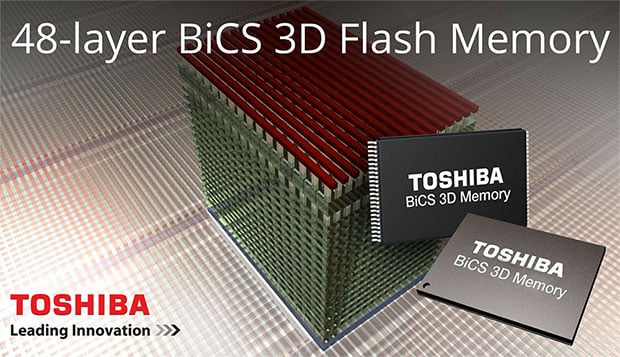SSD Arms Race Heats Up As Toshiba Begins Sampling 48-Layer, 128-Bit 3D NAND
Toshiba and SanDisk announced the joint development of what they claim is the world's first 48-layer three dimensional stacked cell structure flash memory, otherwise known as BiCS (Bit Cost Scalable), a 2-bit-per-cell 128-gigabit (16 gigabytes) device. Put another way, BiCS is essentially Toshiba's version of the 3D NAND flash memory that's shipping with newer Samsung solid state drives (SSDs).
The appeal of a 3D stacked cell structure is that it negates the need to continually shrink the size of NAND flash memory cells by using thinner process technologies and the technological hurdles that go along with it. Instead, stacking the cells allows for greater density and reduces costs, all while maintaining the same or better performance gains. Reliability is improved compared to planar NAND, too.

"We are very pleased to announce our second generation 3D NAND, which is a 48 layer architecture developed with our partner Toshiba," said Dr. Siva Sivaram, executive vice president, memory technology, SanDisk. "“We utilized our first generation 3D NAND technology as a learning vehicle, enabling us to develop our commercial second generation 3D NAND, which we believe will deliver compelling storage solutions for our customers."
Samples of the new 3D NAND are already shipping to clients. Toshiba and SanDisk are planning to mass produce the chips in the first half of 2016 in Fab2 at Yokkaichi Operations, their production site for NAND flash memory that's currently under construction.
What this ultimately means for consumers is larger capacity and better performing SSDs. Intel made a similar announcement this week with its 3D NAND technology that could push 2.5-inch SSDs to 10TB and beyond.
The appeal of a 3D stacked cell structure is that it negates the need to continually shrink the size of NAND flash memory cells by using thinner process technologies and the technological hurdles that go along with it. Instead, stacking the cells allows for greater density and reduces costs, all while maintaining the same or better performance gains. Reliability is improved compared to planar NAND, too.

"We are very pleased to announce our second generation 3D NAND, which is a 48 layer architecture developed with our partner Toshiba," said Dr. Siva Sivaram, executive vice president, memory technology, SanDisk. "“We utilized our first generation 3D NAND technology as a learning vehicle, enabling us to develop our commercial second generation 3D NAND, which we believe will deliver compelling storage solutions for our customers."
Samples of the new 3D NAND are already shipping to clients. Toshiba and SanDisk are planning to mass produce the chips in the first half of 2016 in Fab2 at Yokkaichi Operations, their production site for NAND flash memory that's currently under construction.
What this ultimately means for consumers is larger capacity and better performing SSDs. Intel made a similar announcement this week with its 3D NAND technology that could push 2.5-inch SSDs to 10TB and beyond.

